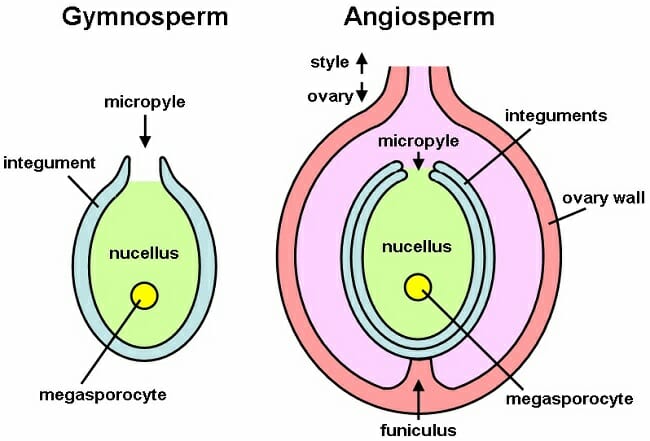Botany Notes On – Ovule – Structure And Forms – For W.B.C.S. Examination.
The ovule is part of the makeup of the female reproductive organ in seed plants. It’s the place where female reproductive cells are made and contained, and it is what eventually develops into a seed after fertilization, only for the seed to then ripen and produce a complete adult plant. Ovules are contained in ovaries at the bottom of a vase-like structure, the carpel, which has a neck called a style and an opening at the top, called a stigma.Continue Reading Botany Notes On – Ovule – Structure And Forms – For W.B.C.S. Examination.
After fertilization the ovule starts to swell and its wall starts to toughen up in preparation to become a seed, while the ovary starts to grow around it and becomes the fruit. Keep in mind that some plants, like the avocado, have a single ovule in their ovary, while others, like the kiwifruit, have many, which develop into many seeds in the fruit. Another way that plants differ with regards to their ovules is the place where the ovules are found. Specifically, in gymnosperms, such as conifers, the ovules are found on the scales of female cones, while in angiosperms, which are flowering plants, the ovules are found inside of the ovary within the carpel.
The ovule is made up of the nucellus, the integuments that form the outermost layer, and the female gametophyte (called an embryo sac in flowering plants), which are found at the very center.
The Nucellus
The nucellus is the largest part of the ovule. It houses the embryo sac as well as nutritive tissue and actually remains present in some flowering plants after fertilization as a source of nutrients for the embyo.
The Integuments
The integument is the tough outer protective layer of the ovule. In the diagrams below we can see that gymnosperms, such as pine trees and spruce trees, usually have one integument in an ovule, so we call them unitegmic. On the other hand, angiosperms, like maples and daisies, typically have two integuments, and we call them bitegmic. The integument encloses the nucellus except for a small gap, which is called the micropyle.
The Female Gametophyte
This is the part of the ovules that contains the gamete-producing sex organs, which are critical for sexual reproduction. The female gametophyte contains a single set of unpaired chromosomes, meaning that it’s haploid. Note that it is commonly called the embryo sac or megagametophyte.
Types of Ovules
Ovules have been separated into six categories based on their shapes:
Orthotropous (Atropous)
This is where the body of these ovules is straight so that the chalaza, where the nucellus and integuments merge, the funicle, which attaches the ovule to the placenta, and the micropyle are all aligned.
Anatropous
In this case, the ovules become completely inverted during development so that the micropyle lies close to the hilum. The hilum is a scar that marks the point where the seed was attached to the fruit wall by the funicle.
Hemi-anatropous
The body of these ovules becomes at a right angle in relation to the funicle, so it looks like the ovule is lying on its side.
Campylotropous
The body of this type is bent and the alignment between the chalaza and micropyle is lost. The embryo sac is only slightly curved.
Amphitropous
The body of the ovule is very much curved that the embryo sac and the ovule itself take the shape of a horseshoe.
Circinotropous
The funicle in this case is especially long that it creates a nearly full circle around the ovule whose micropyle is ultimately pointing upwards.
Functions of Ovules
The ovule plays a vital role in sexual reproduction. Once a pollen grain lands on the stigma of a flower of its same species, it sends out a pollen tube down through the style. This tube then enters the ovary and reaches the ovule of the plant. Once that occurs, fertilization can arise as the nucleus of the pollen grain is sent down the tube to merge with the nucleus in the embryo sac. Note that the male alternative to the ovule is pollen, which contains the male gametophytes.
Please subscribe here to get all future updates on this post/page/category/website


 Toll Free 1800 572 9282
Toll Free 1800 572 9282  mailus@wbcsmadeeasy.in
mailus@wbcsmadeeasy.in



















































































































